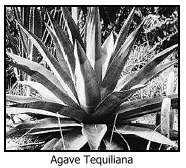
by SALLY AINSWORTH
Sussex biologists are growing
tequila plants in their laboratory
greenhouses. Have scientists
at the University of Sussex become
fed up with paying taxes on their
favourite tipple and resorted to
making their own? Sally Ainsworth
went in search of the truth.
A little crop of Mexican agave is
flourishing thousands of miles from
home in the dismal Sussex winter. The
fermented sugars of Agave tequilana
form the basis of such favourites as the
Margarita, Tequila Sunrise and ‘old
faithful’ Tequila Slammer, underpinning
some of our most memorable (or
least memorable) nights on the town!
Green-fingered DPhil student Ivan
Saldana Oyarzabal has imported eighteen
tequila plants from his native
Mexico for two main reasons (sadly,
neither have anything to do with
tequila!) Here comes the science bit:
 First, the way that agaves photosynthesise
(using the sun’s energy to
make carbohydrate from carbon dioxide
and water) is different to that of
the majority of plants. Interestingly,
agaves have evolved an adaptation to
this process in that they open their
stomata at night to gather CO2 and,
instead of using it right away, store it
overnight until the sun comes up and
the stomata close. During the day,
agaves effectively ‘hold their breath’
while they use sunlight energy to turn
the stored carbon into carbohydrate.
First, the way that agaves photosynthesise
(using the sun’s energy to
make carbohydrate from carbon dioxide
and water) is different to that of
the majority of plants. Interestingly,
agaves have evolved an adaptation to
this process in that they open their
stomata at night to gather CO2 and,
instead of using it right away, store it
overnight until the sun comes up and
the stomata close. During the day,
agaves effectively ‘hold their breath’
while they use sunlight energy to turn
the stored carbon into carbohydrate.
The name given to this method of photosynthesis
is CAM (Crassulacean Acid
Metabolism), and it is frequently associated
with plants in hot, arid regions
where water conservation is of utmost
importance (cacti also photosynthesise
in this way).
The second reason that Ivan is
researching tequila plants is that they
use interesting carbohydrates to store
their energy reserves. The usual products
of photosynthesis in plants are
starch and sucrose, but in agaves the
carbohydrates are made up of chains
of fructose, called fructans. Apart from
being the sugar that (when fermented)
makes tequila, fructans are fascinating
in their own right. The human metabolism
is unable to digest fructans, and
thus they are safe sweeteners for diabetics
and are used widely in the food
industry as low-calorie replacements
for fat and sugar. In addition, they are
heralded as ‘prebiotic’, as they act to
promote the growth of healthy bacteria
in the gut. A downside of this is
flatulence, Jerusalem artichokes are
particularly high in fructans, and if
you’ve ever sampled a Jerusalem one,
you’ll know what I’m saying!
The agave is the only plant to combine
both CAM photosynthesis and
fructan storage, and Ivan’s research
here at Sussex University is the first to
explore how the two are connected.
So, it seems that the BIOLS won’t
be your first port of call when shopping
for your next houseparty. Instead,
Ivan Saldana Oyarzabal is investigating
the link between a photosynthetic
adaptation in plants and the exciting
carbohydrate that they make. At least,
that’s his story.

|
